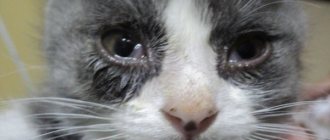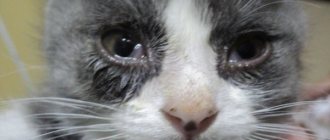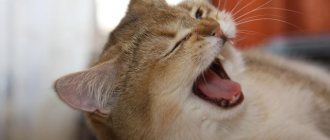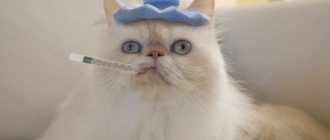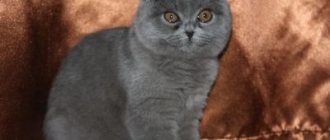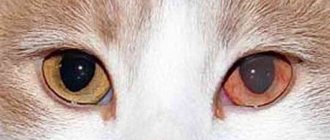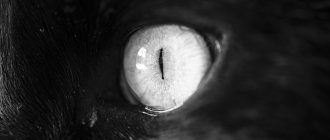Eye diseases in pets are not uncommon. It is important for the owner of the animal to find out why the kitten’s eyes are festering, how to treat the inflammation and how to properly treat the eyelids so that the disease recedes faster. If you notice redness, swelling of the eyes or watery eyes in your pet, you should not hesitate. Lack of treatment can result in damage to the cornea or even loss of vision.
The kitten has conjunctivitis
Suppuration: normal or pathological?
Eye discharge does not always appear due to pathological processes developing in the body.
In some cases, pus in a cat accumulates under the eyelids for the following reasons:
- weakened immune system;
- improperly selected diet (lack of nutrients);
- infectious, viral damage;
- unsanitary conditions when keeping animals;
- draft;
- eye injuries;
- allergic reaction to household chemicals, perfumes;
- inflammatory processes in the cornea (keratitis);
- dust in the room where the pet is kept.
On a note! If the discharge is abundant and prolonged, you should not resort to self-medication; the animal must be taken for examination to a veterinary clinic, where the doctor will determine the cause and prescribe adequate treatment.
The owner should pay attention to the color of the discharge. Rare discharge of a grayish tint is normal, and thick discharge of a yellowish or green tint most likely indicates the development of pathological processes in the body.
When is eye rinsing necessary?
This manipulation is necessary in a number of cases: prevention of secondary infection in case of injury, routine treatment of a contaminated eye in an animal predisposed to contamination, when removing mechanical contaminants and drug residues during treatment of an eye or systemic infection. Let's consider this issue in more detail.
Eye diseases
Conjunctivitis
– inflammation of the mucous membrane of the eye, that is, the conjunctiva, caused by a viral or bacterial infection, allergic reaction, injury, etc. Manifested by swelling of the conjunctiva, redness, active discharge and soreness.
Blepharitis
– an eye disease that affects a cat's eyelids. The eyes look swollen, discharge accumulates around them and dries into crusts, and there is itching and restlessness on the part of the animal.
Glaucoma
– this is a disease that develops as a result of increased intraocular pressure, manifested by damage to the optic nerve and retina. The chronic course of the disease can cause optic nerve atrophy, that is, lifelong blindness. The main manifestations are an increase in the volume of the eyeball, clouding, lacrimation, redness, etc.
Keratitis
– disease of the cornea of the eye. This pathology can be caused either by injury or be secondary to another eye disease. It manifests itself as swelling, lacrimation, clouding of the cornea, and when complicated by a secondary infection – itching and pain.
Cataract
– a rare disease, typical mainly for older animals, which consists of clouding of the lens of the eye. This change can be caused by chronic diseases of the animal - diabetes, trauma, intoxication, metabolic disorders, genetic predisposition, etc. Visually, this condition is noticeable only in the later stages.
Turn of the century
- A fairly rare disease in cats. This is a congenital problem or acquired as a result of long-term inflammatory processes, which is manifested by improper placement of the eyelid and eyelash margin. Most often, it turns inward, thereby constantly injuring the surface of the eye. Visually, this pathology manifests itself very characteristically, but the first thing that owners most often pay attention to is redness, increased discharge from the eyes, and anxiety.
More details about each disease can be found in the article.
Injuries
Mechanical damage to the surface of the eye most often occurs in cats that are on their own or live in contact with other animals. Injuries are caused as a result of mutilation by sharp objects, in fights, falls and other unforeseen situations.
This pathology is manifested by general inflammatory signs - discharge from the eye, swelling, anxiety on the part of the pet, pain. As a result, on the surface of the eye you can see swelling of the corneal tissue - a whitish surface. At the appointment, a doctor who suspects an eye injury conducts a fluorescein staining test. Thus, he details the extent and depth of the lesion - prognosis and further therapy depend on this.
Each disease is unique in its own way and requires an individual approach and prescription. But one thing remains common in treatment - in case of any inflammation, it is necessary to rinse the cat’s eyes and keep them clean. Before any manipulations, administration of drugs - drops or ointments, the owner must thoroughly treat the eye from mechanical impurities and secondary bacterial infections. In advanced diseases, the cat’s eyes have to be washed even to remove pus.
Anatomical features
Some cats have anatomical features of the nasolacrimal duct. For example, narrow, short, folded eye orbits, like exophthalmos, skin folds, occur in short-faced cats - Persians, exotics, Scottish folds. Owners of these cats often experience excessive tearing and tear tracks. Under the eyes of such cats, the secretion of the lacrimal gland often accumulates, in which, over time, harmful bacteria develop, causing a local inflammatory process, alopecia, itching and anxiety on the part of the animal.
It is important for such breeds to pay timely attention, treat and wash their eyes, ensure the prevention of bacterial inflammation, clean the skin and fur around them, without waiting for secondary changes.
Suppuration: 5 main reasons
The main reasons for the appearance of pus:
- Thick, yellow pus is a sign of an infectious, viral, or fungal disease. The cause of this symptomatology is bacteria or viruses that have entered the animal’s body. Associated symptoms: increased body temperature, apathy, refusal to eat, matted fur around the eyes.
- Cold. If a kitten has a cold, purulent discharge can serve as one of the symptoms of a cold, additional symptoms: sneezing, mucus discharge from the nasal passages, lethargy, chills.
- Ophthalmological diseases. Pathologies of the eyelids, inflammation of the cornea, conjunctiva, blepharitis can become the reason due to which suppuration begins on the organs of vision.
- Allergic reaction. Pus can be released if the animal is allergic to food, household chemicals, perfumes, or pollen.
- In case of mechanical damage to the eye, the wound may become infected, in these cases pus will begin to ooze from the organ of vision.
Be sure to read:
What should you do if your cat develops a lump at or near the injection site after vaccination? When does a tumor become oncology?
Treatment
You cannot do without a visit to the veterinarian. A specialist will examine the kitten’s sore eyes and find out the causes of suppuration. Sometimes it is impossible to establish an accurate diagnosis with the help of an initial examination. In this case, the veterinarian will refer you for additional diagnostics. More experienced doctors will take tests and give an accurate diagnosis. Only after this can effective treatment begin.
Attention! Viral causes of eye suppuration are difficult to treat with folk remedies. Therefore, all “grandmother’s” methods are suitable only as a preventive measure or to accelerate recovery from mechanical damage to the tissue around the eyes.
Recommended drugs
Here are the most popular eye medications for kittens recommended by doctors:
- Tsiprolet. The active substance is ciprofloxacin. It has a local bactericidal and anti-inflammatory effect. Effective against eye damage from infections and microorganisms. For example, staphylococcus, Pseudomonas aeruginosa, chlamydia. This is a prophylactic agent that is used in the initial stages of suppuration. Dosage – 1 drop 3-4 times a day. If persistent purulent and mucous discharge is observed, the dose is increased.
- Levomycetin. The antibiotic drug kills bacteria that are resistant to penicillin and its derivatives. It can cure a kitten’s eyes from conjunctivitis, blepharitis and keratitis. This is a well-known effective antibiotic with positive reviews.
- Diamond eyes. The active ingredients are chlorhexidine and taurine. It is used for all types of conjunctivitis and degenerative changes in the retina. Drops are a good preventative against cataracts. The dosage depends on the duration of treatment: 1 drop per day – 45 days, 2 drops per day – 20 days, 3 drops per day – 10 days.
- Leopard. The active substances are chloramphenicol and furatsilin. The drug has extensive antibacterial effects and provides good relief from conjunctivitis, keratitis and blepharitis. Dosage – 1-2 drops 3-4 times a day.
- Iris. The main antibacterial substance is gentamicin sulfate. Treats conjunctivitis in acute and chronic stages, blepharitis, stye, septic ulcers of the cornea. Used for injuries, wounds, mechanical damage to the eyes. Use strictly according to instructions.
- Tsiprovet. The active substance and pharmacological action are exactly the same as those of the drug Tsiprolet. Destroys single-celled microorganisms that parasitize the mucous membrane of the eye.
- Tetracycline ointment. This is a broad-spectrum antibiotic. Apply under the eyelid and on the area around the eyes in small doses.
How to put medicine in a kitten's eyes
In order for the kitten to remain calm and easy to handle, it is necessary to do everything confidently and calmly, without raising your voice or making sudden movements. Before using the medicine, you need to rinse your eyes from pus, so the active substances in drops and ointments will be absorbed faster. We have written recipes for infusions and eye wash solutions just below.
How to apply drops:
- Place the pet on your lap and pet it.
- Soak sticky eyelids with chamomile decoction, a weak solution of potassium permanganate (potassium permanganate) or any other antiseptic in liquid form.
- Wait until the pus softens, and then remove it with extreme caution using a cotton pad, or better yet, a piece of bandage. This way the cotton wool will definitely not get into the eye.
- Apply the medicine according to this principle: use the fingers of one hand to slightly spread the eyelids, and apply drops with the other hand. The drop should rinse the mucous membrane well and get behind the eyelid. Gently cover the eyelid with your finger so that the medicine is distributed over the entire surface of the eyeball.
Advice! It is difficult for one person to hold an active kitten, much less administer the product. You can arm yourself with support and treat your baby’s eyes with four hands.
The ointment is applied as follows:
- Place the pet on its side so that its head faces the person.
- Lift the eyelid and apply a little ointment under it.
- Close your eye and massage it lightly with your fingertip. This way the ointment can be distributed evenly. You cannot press your hand on the eye while massaging the eyelid: this will cause enormous pain.
Important! If the pus is caused by viruses, then the risk of infecting other cats in the house increases dramatically. Therefore, the owner is faced with the task of protecting healthy babies. All kittens from lambing and adult cats should be treated with the drugs.
Typically an adult cat gives birth to 2 to 7 kittens. A large number of children complicates examination and treatment. We recommend contacting a veterinarian who makes house calls. A specialist will conduct an initial examination in a quiet home environment and, if necessary, take tests.
What can you do before visiting a doctor?
If there is heavy discharge, do not put off going to the veterinarian. Before going to the veterinary clinic, you can relieve your pet's condition by rinsing the eyes yourself.
Until the causes of the disease are determined and adequate therapy is prescribed, the following should be used:
- weak solution of potassium permanganate,
- herbal infusion,
- decoction of tea leaves.
Any of the above products must be cooled to room temperature.
How to carry out the procedure:
- Calm the animal, secure the paws with a towel, wrap the entire body, and lay it on its side.
- Use a pipette or syringe without a needle to drip warm boiled water onto your eyes to soften dried discharge, and gently wipe your eyelids with a swab.
- Moisten 2 cosmetic discs generously in the solution, wipe each eye with a separate disc.
On a note! To avoid infection in a healthy organ of vision, you should take a new cotton pad after each wiping; repeated use is unacceptable.
During treatment, do not bring the syringe or pipette close to the eyes; the kitten may twitch, which will lead to mechanical injury. Processing is carried out from the outer corner towards the inner.
Health Hazard
Discharge from the eyes is a clear sign that indicates the presence of an infection in the body. Ignoring the first symptoms and untimely treatment can negatively affect the body of a small pet. Without treatment, it can lead to complete loss of vision.
Attention! Pus is normal for newborns. However, greenish or light gray discharge with a strong unpleasant odor indicates serious problems in the body. You should contact your veterinarian as soon as possible.
Suppuration with a runny nose, what to do
Eye discharge accompanied by chills, sneezing, and snot most often indicate a runny nose. For a fragile body, a runny nose can serve as an impetus for the development of serious diseases, such as viral rhinotracheitis or calcivirosis.
If you suspect the development of the disease, you should take the animal to a veterinary clinic, where a doctor will examine it, prescribe tests and a treatment regimen.
Medicines that are most often prescribed for colds to treat suppuration:
- anti-inflammatory drugs,
- antibiotics,
- immunomodulators.
What drops and ointments to use
For ocular discharge, veterinarians advise using various ointments and drops for treatment. In order for the drug to be beneficial, the owner must follow a number of rules.
How to instill drops:
- Pre-rinse the eye mucosa with herbal decoction or tea leaves.
- Secure the pet and lay it on its side.
- Pipette drops at room temperature.
- Gently drip into outer corners.
- Remove residues with a dry cotton pad.
Be sure to read:
The cat eats poorly and constantly sleeps, is lethargic: normal or pathological, the reason, what to do when you need help
How to apply the ointment:
- Warm the prescribed drug in your palms to room temperature.
- Secure the pet with a towel and lay it on its side.
- With clean hands, place the ointment under the lower eyelids, pulling them slightly.
- Massage the eyelids with the ointment for a few seconds.
- Rub the treated eyes with a dry cotton swab to remove excess.
Commonly prescribed ointments:
- tetracycline eye ointment,
- hydrocortisone,
- solcoseryl.
Popular drops:
- albucid,
- gentamicin drops,
- veterinary drops “Iris”, “Bars”, “Diamond Eyes”,
- levomecithin drops.
Prevention
To prevent your kitten from suffering from conjunctivitis and other eye diseases, you need to keep your eyes clean every day. To do this, use regular saline solution or boiled water. Using a damp cotton pad, gently remove dirt from the eyelids.
It is very important to maintain your pet's immunity. The diet should be varied. The cat's menu includes not only meat, but also vegetables, fermented milk products, and quail eggs. You should protect your four-legged friend from contact with stray animals, as they often suffer from various infections. Vaccination will help prevent infection with dangerous diseases.
If your kitten's eyes are swollen and red, the first thing to do is take him to the vet and find out what is causing the problem. He will prescribe treatment after diagnosis. In most cases, you can get rid of conjunctivitis within a week if you follow all the doctor’s recommendations.
How to treat at home
At home, you can try to get rid of pus by regularly treating the mucous membranes of the eyes with a solution of furatsilin, a decoction of medicinal herbs.
It is not advisable to use eye drops purchased at a pharmacy without a prescription from a veterinarian. A dosage suitable for humans can lead to serious consequences if used on a kitten.
You can put tetracycline eye ointment under the patient's lower eyelids.
If the kitten’s condition does not improve 2-3 days after the start of treatment, a visit to the veterinary clinic should be made.
Types of eyelid diseases and their treatment
Symptoms and methods of treating eye diseases in cats depend not only on the cause, but also on the area of the lesion. The main blow is always taken by the eyelids, which protect the more delicate layers from the aggressive influence of the external environment.
Blepharitis
Staphylococcal infections that enter the eye cause unilateral or internal blepharitis in cats. This disease is accompanied by severe redness and inflammation of the corners of the eyelid, as well as the discharge of purulent exudate. Dried pus gradually covers the entire affected area, causing thickening and ulceration of the skin.
In addition to infection, blepharitis can be caused by allergies or demodicosis. Inflammation is treated with antibiotics, antihistamines or acaricidal drugs.
Third eyelid prolapse
This term refers to the transparent nictitating membrane, which performs a protective and moisturizing function. It is located in the inner corner of the eye next to the nose. Its loss is accompanied by uncontrollable twitching of the eyelids, lacrimation and copious discharge of pus or mucus.
Pathology develops with infections, allergies, parasitosis, foreign objects and fusion of the eyelids with each other. To reduce it, they resort to surgery.
Entropion of the eyelids
An alternative name for this disease is entropion. Most often it affects the lower eyelid, causing photophobia and excessive lacrimation. With entropion, it is very easy to understand that something is wrong with the cat’s eye, because she experiences severe pain due to prickly eyelashes and hairs.
The pathology is caused by congenital disorders, injuries and neoplasms. The problem is eliminated by excision of excess skin and formation of the correct palpebral fissure.
Ptosis
Characterized by involuntary drooping of the upper eyelid. The diseased eye opens only partially, and the palpebral fissure narrows. Ptosis occurs as a result of complications of inflammatory processes, paralysis of the facial nerve or weakness of the orbicularis muscle covering the anterior parts of the orbit. It is treated exclusively by surgery.
Lagophthalmos
External signs of lagophthalmos are similar to ptosis. The difference is that the eyelids cannot close. Because of this, the cat has to sleep with its eyes open. The causes and treatment are the same as ptosis.
Fusion of the eyelids with each other or with the conjunctiva
The first type of disorder is called ankyloblepharon, and the second - symblepharon. These pathologies develop from birth, with chronic blepharitis and as a result of mechanical damage. Both cases are accompanied by tissue scarring and the inability to open the eyes. To eliminate the fusion, the help of a surgeon is required.
Folk remedies
At home, for rinsing, it is recommended to use infusions, solutions, and decoctions prepared on the basis of medicinal herbs.
- Rinse with saline solution.
Add half a teaspoon of table salt to 500 ml of chilled boiled water and stir thoroughly. Rinse eyes 2-3 times a day with cotton pads. Do not use if the condition is caused by an allergen entering the body.
- Treatment with herbal infusion.
Prepare a mixture of dried herbs (calendula, sage) at a ratio of one to one. Pour a couple of tablespoons of the mixture into 500 ml of cold water, place in a steam bath, cook for 12-15 minutes, strain, cool. Carry out treatment several times a day.
- Washing with tea.
Pour a glass of boiling water over a bag of green tea and let it brew. Rinse the organs of vision in case of mechanical injuries, inflammatory processes to relieve inflammation.
- Treatment with solutions of furatsilin, boric acid.
Be sure to read:
A cat eats poorly: normal or pathological, reasons, first aid, what to do, how to get it to eat
Prepare a solution at the rate of: 2 drops of furatsilin per tablespoon of boiled water or a pinch of boric acid per glass of boiled water. Treat 2 times a day.
Causes and symptoms of eye inflammation in cats
All cats have unusually sharp eyesight, so eye problems are really serious for your pet. Often eye diseases are symptoms of more serious disorders in the functioning of the furry body. Thus, the cause of inflammation of the visual organs may be a genetic predisposition to this (especially among Persians and British), mechanical trauma (a foreign object entering the eye) or internal pathologies. The main symptoms of inflammation are redness of the organs of vision, aggression, lethargy, swelling of the eyes, and the release of tears or other fluids.
Medications
- Hydrocortisone drops with novocaine - to relieve swelling, inflammation, pain.
- Gentamicin drops - for severe inflammatory processes.
- Albucid drops - for the treatment of injuries.
- Drops with chloramphenicol - for infectious lesions.
- Drops with atropine - for the development of photophobia.
- Solcoseryl ointment - for healing mucous membranes in case of injuries.
- Tetracycline ointment for allergic reactions, to relieve inflammation.

